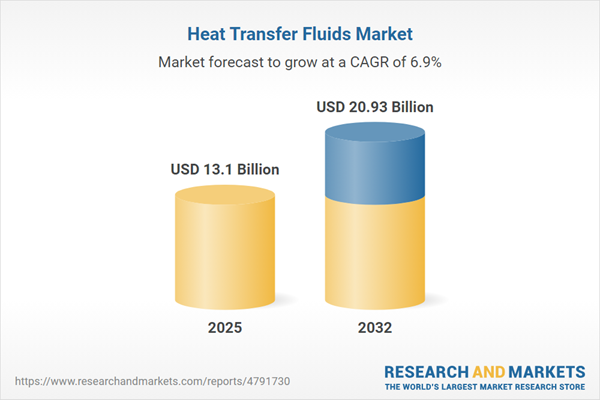Speak directly to the analyst to clarify any post sales queries you may have.
Senior executives across global industries are navigating increased demands for regulatory alignment, sustainable operations, and streamlined procurement. Organizations face pressure to enhance operational resilience as the heat transfer fluids market responds to evolving compliance and sustainability standards.
Market Snapshot: Heat Transfer Fluids Market
The global heat transfer fluids market is valued at USD 12.23 billion in 2024, with a projected increase to USD 13.10 billion by 2025. Continuing on a robust upward trajectory, market value is forecast to reach USD 20.93 billion by 2032, supported by a 6.94% compound annual growth rate. Sector growth is being shaped by widespread industry adoption, large-scale investments in renewable energy infrastructure, and a rapidly changing regulatory environment. In response, leading market players are accelerating product development, investing in optimized supply chain models, and modernizing operations to achieve compliance across regions. This proactive environment sustains investment and continuous improvement, enhancing global competitiveness and supporting long-term business growth.
Scope & Segmentation: Actionable Insights for Heat Transfer Fluids
Strategic segmentation of the heat transfer fluids market enables tailored solutions and refined resource allocation. Deep understanding of each segment ensures business operations remain compliant, efficient, and resilient in the face of regulatory or market change.
- Product Types: Aromatic fluids, glycol-based fluids, mineral oils, and silicone fluids offer distinct profiles for thermal stability, efficiency, and safety, addressing unique application and compliance needs.
- Temperature Range: High, medium, and low-temperature fluids are aligned to diverse industrial process environments, ensuring production continuity and protecting key equipment assets.
- Chemical Composition: Inorganic and organic fluid formulations help organizations address lifecycle performance, durability, and environmental mandates, a key differentiator for industries governed by rigorous standards.
- End-Use Industries: Automotive, chemical processing, food and beverage, oil and gas, pharmaceuticals, and power generation industries depend on application-specific fluids to meet performance targets and limit disruptions.
- Distribution Channel: Online and offline procurement routes offer flexibility and redundancy, supporting uninterrupted operations in distributed and dynamic contexts.
- Regions: The Americas, Europe, Middle East, Africa, and Asia-Pacific display varied demand patterns and market dynamics. Core countries including the United States, China, India, Germany, and Brazil reflect regional business priorities, shape innovation, and drive strategic supplier decisions.
- Leading Companies: Arkema S.A., Arteco NV, BASF SE, Clariant AG, ConocoPhillips Company, Dow Chemical Company, Dynalene Inc., Eastman Chemical Company, ExxonMobil Corporation, Honeywell International Inc., and Huntsman International LLC influence advancements in product design, industry standardization, and global partnership frameworks.
Key Takeaways for Senior Decision-Makers
- Adopting advanced heat transfer fluids assists with meeting regulatory mandates and reinforces organizational sustainability goals, fostering operational practices that adapt to changing requirements.
- Integrating digital monitoring tools and predictive analytics promotes proactive maintenance strategies, helping maximize asset utilization and lower operating disruptions across production environments.
- Maintaining strict quality assurance supports adherence to industry requirements, particularly where fluid quality and reliability are central to compliance.
- Selecting bio-based and low global warming potential fluids aligns sourcing practices with rising environmental expectations and strengthens responsible procurement.
- Developing robust supplier networks and collaborating on technology initiatives enhances supply assurance and accelerates access to evolving technical solutions.
- Employing flexible procurement approaches helps organizations navigate fluctuating market policies, strengthening resilience against sector volatility or sudden regulatory shifts.
Tariff Impact: Navigating 2025 US Tariffs and Trade Dynamics
Forthcoming 2025 US tariffs are prompting reassessment of sourcing and cost structures across the heat transfer fluids sector. Enterprises are considering vertical integration to improve supply assurance and manage expenses, with an increased focus on domestic manufacturing. At the same time, commitment to compliance drives some organizations to build or reinforce regional supply partnerships, supporting agility and continuity despite policy adjustments. These multifaceted approaches ensure businesses can protect operations and remain competitive within a shifting global value chain.
Research Methodology & Data Sources
This market analysis draws on structured interviews with senior executives, technical specialists, and relevant regulators to provide a holistic industry view. All findings are subject to expert advisory validation, ensuring reliable insights for informed decision-making.
Why This Report Matters
- Delivers actionable market intelligence, guiding leaders in choosing technology and compliance paths that correspond to current sector trends.
- Clarifies segment-specific operational risks and resource priorities for more agile decision-making as industry and regional landscapes evolve.
- Supports enhanced supply chain strategies, enabling organizations to address operational and regulatory changes confidently and effectively.
Conclusion
This report enables senior executives to monitor emerging trends, adjust operational approaches, and strengthen market position as the heat transfer fluids sector advances.
Additional Product Information:
- Purchase of this report includes 1 year online access with quarterly updates.
- This report can be updated on request. Please contact our Customer Experience team using the Ask a Question widget on our website.
Table of Contents
3. Executive Summary
4. Market Overview
7. Cumulative Impact of Artificial Intelligence 2025
Companies Mentioned
The companies profiled in this Heat Transfer Fluids market report include:- Arkema S.A.
- Arteco NV
- BASF SE
- Clariant AG
- ConocoPhillips Company
- Costel Thermal Fluids Ltd.
- Dow Chemical Company
- Dynalene Inc.
- Dynasol Elastomers LLC
- Eastman Chemical Company
- ExxonMobil Corporation
- General Electric Company
- Gulf Oil Corporation Ltd.
- Honeywell International Inc.
- Huntsman International LLC
Table Information
| Report Attribute | Details |
|---|---|
| No. of Pages | 180 |
| Published | November 2025 |
| Forecast Period | 2025 - 2032 |
| Estimated Market Value ( USD | $ 13.1 Billion |
| Forecasted Market Value ( USD | $ 20.93 Billion |
| Compound Annual Growth Rate | 6.9% |
| Regions Covered | Global |
| No. of Companies Mentioned | 16 |









